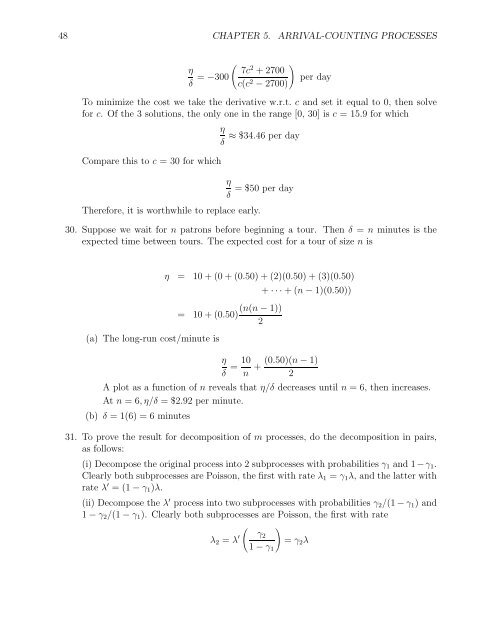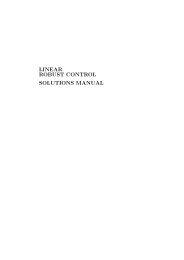SOLUTIONS MANUAL for Stochastic Modeling: Analysis and ...
SOLUTIONS MANUAL for Stochastic Modeling: Analysis and ...
SOLUTIONS MANUAL for Stochastic Modeling: Analysis and ...
Create successful ePaper yourself
Turn your PDF publications into a flip-book with our unique Google optimized e-Paper software.
48 CHAPTER 5. ARRIVAL-COUNTING PROCESSES<br />
(<br />
η 7c 2 )<br />
δ = −300 + 2700<br />
c(c 2 − 2700)<br />
per day<br />
To minimize the cost we take the derivative w.r.t. c <strong>and</strong> set it equal to 0, then solve<br />
<strong>for</strong> c. Of the 3 solutions, the only one in the range [0, 30] is c = 15.9 <strong>for</strong> which<br />
η<br />
≈ $34.46 per day<br />
δ<br />
Compare this to c =30<strong>for</strong>which<br />
η<br />
= $50 per day<br />
δ<br />
There<strong>for</strong>e, it is worthwhile to replace early.<br />
30. Suppose we wait <strong>for</strong> n patrons be<strong>for</strong>e beginning a tour. Then δ = n minutes is the<br />
expected time between tours. The expected cost <strong>for</strong> a tour of size n is<br />
(a) The long-run cost/minute is<br />
η = 10+(0+(0.50) + (2)(0.50) + (3)(0.50)<br />
+ ···+(n − 1)(0.50))<br />
(n(n − 1))<br />
= 10+(0.50)<br />
2<br />
η<br />
δ = 10 (0.50)(n − 1)<br />
+<br />
n 2<br />
A plot as a function of n reveals that η/δ decreases until n = 6, then increases.<br />
At n =6,η/δ =$2.92 per minute.<br />
(b) δ =1(6)=6minutes<br />
31. To prove the result <strong>for</strong> decomposition of m processes, do the decomposition in pairs,<br />
as follows:<br />
(i) Decompose the original process into 2 subprocesses with probabilities γ 1 <strong>and</strong> 1−γ 1 .<br />
Clearly both subprocesses are Poisson, the first with rate λ 1 = γ 1 λ, <strong>and</strong> the latter with<br />
rate λ ′ =(1− γ 1 )λ.<br />
(ii) Decompose the λ ′ process into two subprocesses with probabilities γ 2 /(1 − γ 1 )<strong>and</strong><br />
1 − γ 2 /(1 − γ 1 ). Clearly both subprocesses are Poisson, the first with rate<br />
( )<br />
λ 2 = λ ′ γ2<br />
= γ 2 λ<br />
1 − γ 1















